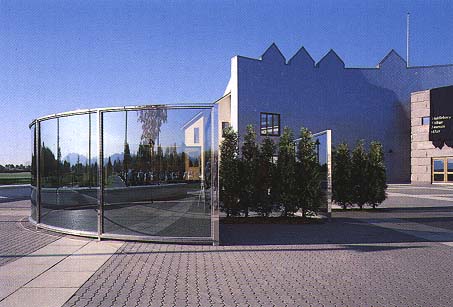
Two-Way Mirror Curved Hedge Zig-Zag Labyrinth is an outdoor sculpture located on the patio behind the Mahaney Arts Center. Audio guide length: 3 minutes, 5 seconds.
Two-Way Mirror Curved Hedge Zig-Zag Labyrinth is a large, outdoor sculpture made of glass, metal, and cedar hedges. The piece was made in 1996 by the American artist Dan Graham. It is 7 and 1/2 feet tall, with a radius of 15 feet. The sculpture consists of a series of connected walls forming a semi-enclosed space. You are welcome to touch this sculpture with care, smell the hedges, and enjoy the echoes produced when you speak inside of the sculpture.
To understand the shape of this sculpture, imagine the circle of a clock. A glass wall traces the rim of the clock from 12 to 6. The second half of the sculpture cuts diagonally across the clock from 12 to 9. This second half is made up of two right angles, which create a W- or M-shaped zig-zag pattern. Each turn on this zig-zagged wall alternates between glass and cedar hedges. The height of the glass and hedges is about the height of a typical room. Stepping into the interior of the sculpture feels similar to standing in a room with glass windows, but this feeling is countered by the open sky above and the natural hedges.
[If you would like further description and analysis of this sculpture, please continue listening or reading.]
One way to interpret this piece is to consider the materials used to make it. This construction is created with a combination of industrial and natural materials. The glass and metal components in this work are the same used in large skyscrapers and urban architecture. These industrial materials are juxtaposed with cedar tree hedges that have a rough, piney texture. This sculpture was designed specifically for its site on the plaza of the Mahaney Arts Center. Unlike covered pavilions often found in gardens and parks, Graham’s roofless sculpture does not have any apparent practical function. Here, public space is used to invite viewers to actively engage with art. The more time one spends with this piece, the more ways of experiencing it appear. The curvature of the glass windows distorts your reflection, stretching it apart and bending it together again, like a carnival fun house mirror. Looking through the glass at different angles offers framed views of both the Mahaney Arts Center and the pastoral Vermont landscape. The pavilion’s industrial materials create an echoing sound, and even the smell of cedar contributes to the viewing experience. Through this interactive work, Dan Graham invites us to consider our own relationships with the built and natural environment.